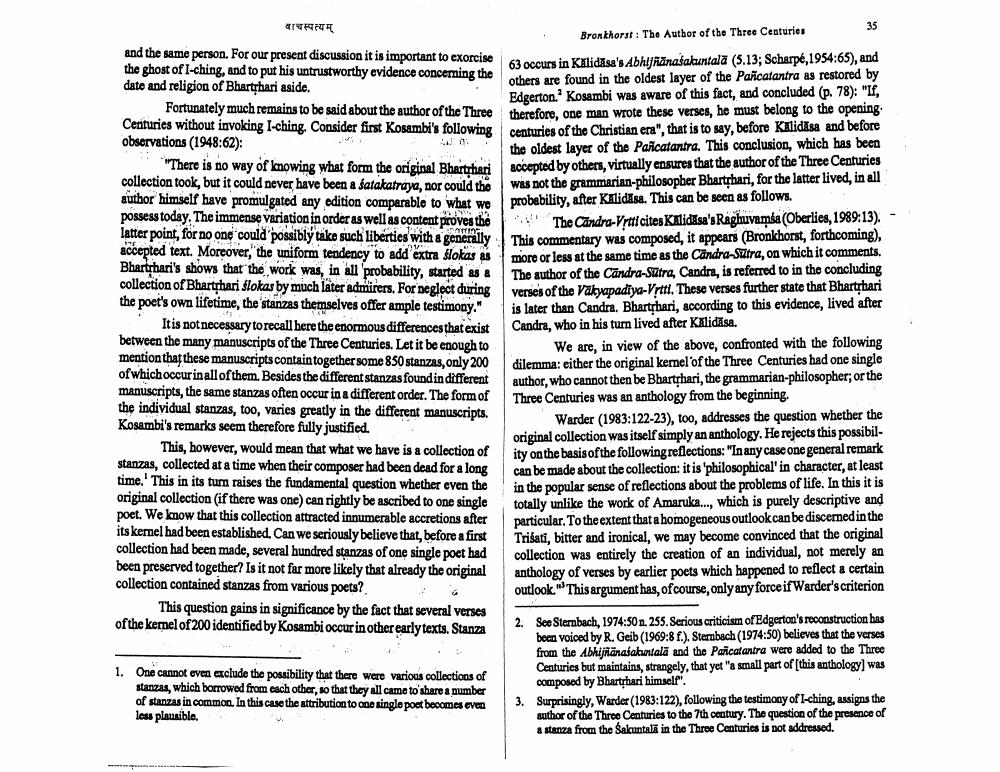Book Title: Author Of Three Centuries Author(s): Johannes Bronkhorst Publisher: Johannes Bronkhorst View full book textPage 2
________________ वाचस्पत्यम् 35 Bronkhorst: The Author of the Threc Centuries and the same person. For our present discussion it is important to exorcise the ghost of I-ching, and to put his untrustworthy evidence concerning the date and religion of Bharthari aside. Fortunately much remains to be said about the author of the Three Centuries without invoking I-ching. Consider first Kosambi's following observations (1948:62): "There is no way of knowing what form the original Bharthari collection took, but it could never have been a Satakatraya, nor could the author himself have promulgated any edition comparable to what we possess today. The immense variation in order as well as content proves the latter point, for no one could possibly tako such liberties with a generally accepted text. Moreover," the uniform tendency to add extra flokas as Bharthari's shows that the work was, in all probability, started as a collection of Bhartrhari Slokas by much later admirers. For neglect during the poet's own lifetime, the starizas themselves offer ample testimony." It is not necessary to recall here the enormous differences that exist between the many manuscripts of the Three Centuries. Let it be enough to mention that these manuscripts contain together some 850 stanzas only 200 of which occur in all of them. Besides the different stanzas found in different manuscripts, the same stanzas often occur in a different order. The form of the individual stanzas, too, varies greatly in the different manuscripts. Kosambi's remarks seem therefore fully justified. This, however, would mean that what we have is a collection of stanzas, collected at a time when their composer had been dead for a long time. This in its tum raises the fundamental question whether even the ther even the original collection (if there was one) can rightly be ascribed to one single poet. We know that this collection attracted innumerable accretions after its kernel had been established. Can we seriously believe that, before a first collection had been made, several hundred stanzas of one single poet had been preserved together? Is it not far more likely that already the original collection contained stanzas from various poets? This question gains in significance by the fact that several verses of the kernel of 200 identified by Kosambi occur in other early texts. Stanza 63 occurs in Kalidasa's Abhijñānasakuntala (5.13; Scharpé,1954:65), and others are found in the oldest layer of the Pancatantra as restored by Edgerton. Kosambi was aware of this fact, and concluded (p. 78): "If, therefore, one man wrote these verses, he must belong to me opeus centuries of the Christian era", that is to say, before Kalidasa and before the oldest layer of the Parcatantra. This conclusion, which has been accepted by others, virtually ensures that the author of the Three Centuries was not the grammarian-philosopher Bharthari, for the latter lived, in all probability, after Kalidasa. This can be seen as follows. The Candra-Vrtti cites Kalidasa's Raghuvamsa (Oberlies, 1989:13). - This commentary was composed, it appears (Bronkhorst, forthcoming), more or less at the same time as the Candra-Sutra, on which it comes. The author of the Candra-Sutra, Candra, is referred to in the concluding verses of the Vakvapadiva-Vrtti. These verses further state at banquam is later than Candra. Bhartphari, according to this evidence, lived after Candra, who in his turn lived after Kalidasa. We are, in view of the above, confronted with the following dilemma: either the original kernel of the Three Centuries had one single author, who cannot then be Bharthari, the grammarian-philosopher; or the Three Centuries was an anthology from the beginning. Warder (1983:122-23), too, addresses the question whether the original collection was itself simply an anthology. He rejects this possibility on the basis of the following reflections: "In any case one general remark can be made about the collection: it is 'philosophical' in character, at least in the popular sense of reflections about the problems of life. In this it is totally unlike the work of Amaruka..., which is purely descriptive and particular. To the extent that a homogeneous outlook can be discerned in the Trišati, bitter and ironical, we may become convinced that the original collection was entirely the creation of an individual, not merely an anthology of verses by earlier poets which happened to reflect a certain outlook. This argument has, of course, only any force if Warder's criterion 1. One cannot even exclude the possibility that there were various collections of stanzas, which borrowed from each other, so that they all came to share a number of stanzas in common. In this case the attribution to one single poet becomes even loss plausible. 2. See Sternbach, 1974:50 n. 255. Serious criticism of Edgerton's reconstruction has been voiced by R. Geib (1969:8 f.). Sternbach (1974:50) believes that the verses from the Abhijilānasakuntala and the Parcatantra were added to the Three Centuries but maintains, strangely, that yet "a small part of [this anthology] was composed by Bharthari himself". 3. Surprisingly, Warder (1983:122), following the testimony of I-ching, assigns the author of the Three Centuries to the 7th century. The question of the presence of a stanza from the Sakuntalā in the Three Centuries is not addressed.Page Navigation
1 2 3 4 5
